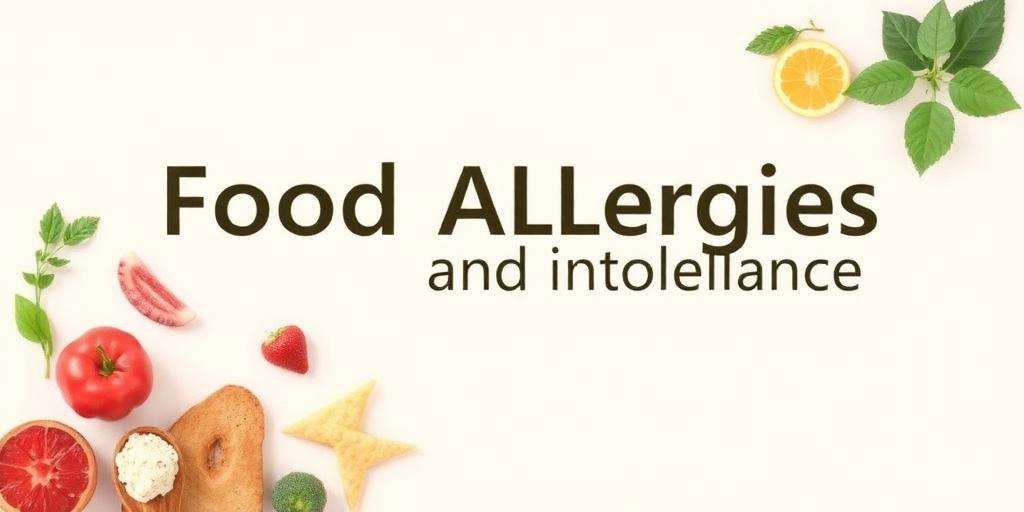Food Allergies and Intolerances: Navigating Your Diet
Understanding the difference between food allergies and intolerances is crucial for managing your diet and overall health. While both can cause discomfort, they affect your body in different ways. This article will explore the key differences, common symptoms, diagnostic methods, and strategies for navigating your diet.
What are Food Allergies?
Food allergies involve the immune system. When you have a food allergy, your immune system mistakenly identifies a specific food protein as harmful and triggers an allergic reaction. This reaction can range from mild to severe and can be life-threatening in some cases (anaphylaxis).
Common Symptoms of Food Allergies:
- Hives
- Itching or eczema
- Swelling of the lips, tongue, throat, or face
- Wheezing or difficulty breathing
- Abdominal pain, diarrhea, nausea, or vomiting
- Dizziness or fainting
The most common food allergens are often referred to as the "Big Eight":
- Milk
- Eggs
- Peanuts
- Tree nuts
- Soy
- Wheat
- Fish
- Shellfish
What are Food Intolerances?
Food intolerances, unlike allergies, do not involve the immune system. Instead, they usually occur because your body has difficulty digesting a particular food. This can be due to enzyme deficiencies, sensitivity to food additives, or other factors.
Common Symptoms of Food Intolerances:
- Bloating
- Gas
- Diarrhea
- Abdominal pain or cramping
- Headaches or migraines
- Fatigue
Common culprits behind food intolerances include lactose (in dairy products), gluten (in wheat, barley, and rye), and certain food additives like artificial sweeteners and preservatives.
Diagnosing Food Allergies and Intolerances
Accurate diagnosis is crucial for managing food-related issues effectively.
Diagnosing Food Allergies:
- Skin Prick Test: A small amount of allergen is placed on the skin, which is then pricked to see if a reaction occurs.
- Blood Test (Specific IgE Antibody Test): Measures the amount of IgE antibodies related to specific allergens in your blood.
- Oral Food Challenge: Under medical supervision, you eat small amounts of the suspected allergen to monitor for a reaction.
Diagnosing Food Intolerances:
- Elimination Diet: You remove suspected foods from your diet for a period, then reintroduce them one at a time to identify triggers.
- Hydrogen Breath Test: Used to diagnose lactose intolerance by measuring the amount of hydrogen in your breath after consuming lactose.
- Food Diary: Keeping a detailed record of what you eat and any symptoms you experience can help identify patterns.
Navigating Your Diet with Food Allergies or Intolerances
Living with food allergies or intolerances requires careful planning and attention to detail.
Tips for Managing Food Allergies:
- Read Labels Carefully: Always check ingredient labels for potential allergens.
- Inform Restaurant Staff: When eating out, inform the staff about your allergies to avoid cross-contamination.
- Carry an Epinephrine Auto-Injector: If you have a severe allergy, carry an epinephrine auto-injector (EpiPen) and know how to use it.
- Educate Family and Friends: Make sure your loved ones understand your allergies and how to respond in an emergency.
Tips for Managing Food Intolerances:
- Identify Trigger Foods: Use an elimination diet or food diary to pinpoint which foods cause symptoms.
- Limit Portion Sizes: Sometimes, you can tolerate small amounts of a problematic food without experiencing symptoms.
- Find Alternatives: Explore alternative foods that provide similar nutrients without causing discomfort (e.g., lactose-free dairy products).
- Consider Enzyme Supplements: Supplements like lactase can help you digest certain foods more easily.
Conclusion
Understanding the differences between food allergies and intolerances is the first step toward managing your diet and improving your well-being. By identifying your triggers, working with healthcare professionals, and making informed dietary choices, you can navigate your diet with confidence and enjoy a healthier, more comfortable life.









